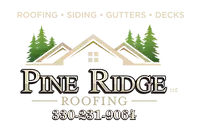Sugar Bush Knolls Roof Damage by Weather Conditions and Insurance Claims - A Comprehensive Guide
Your dwelling serves as your sanctuary, and the integrity of your roof is paramount to ensuring its safety and security. So, what transpires when unavoidable roof damage by weather conditions befalls your abode? Navigating the labyrinth of roof damage types induced by the elements, unraveling the intricacies of insurance claims, and embracing the nuances of roof maintenance can significantly impact the preservation of your investment.
This extensive guide is designed to escort you through the essentials, empowering you to shield your home and confront roof damage by weather conditions and insurance claims with assurance.
In Sugar Bush Knolls, roof damage is a recurring consequence of severe weather conditions such as storms, high winds, tornadoes, and hail. Pine Ridge Roofing stands ready to lend support in addressing these challenges.
Key Takeaways
Table of Contents
Sugar Bush Knolls Roof Damage - Types of Weather-Related Roof Damage
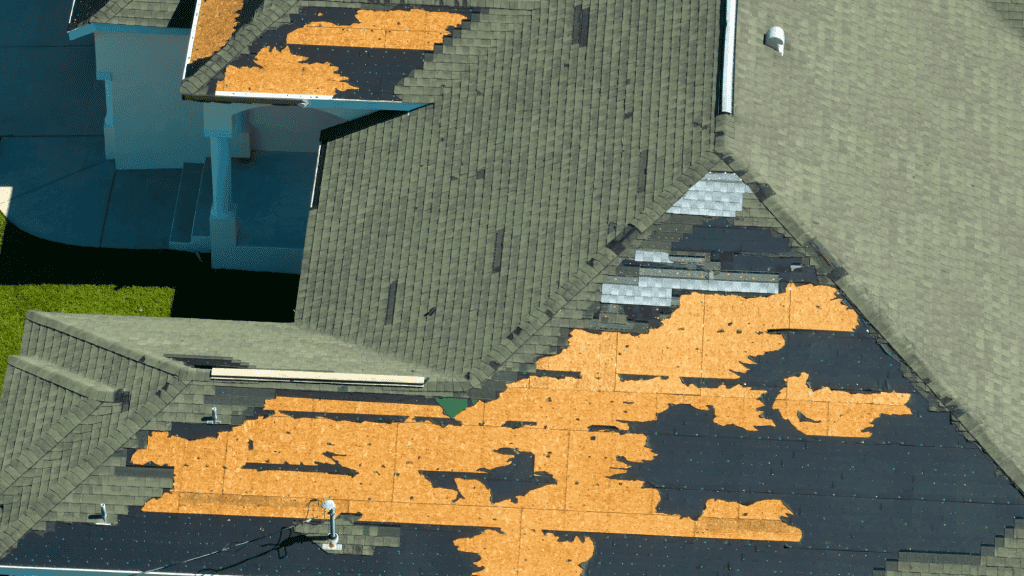
In Sugar Bush Knolls, roof damage from unpredictable weather conditions is a prevalent concern. Weather elements such as wind, hail, rain, or snow can wreak havoc on roofs, frequently resulting in insurance claims and the need for expensive repairs or replacements.
Safeguarding your home involves identifying signs of storm damage and understanding how these natural forces affect your roofing materials.
A critical question often arises: Is roof damage covered by insurance? To secure coverage for your roof damage expenses through home insurance, it’s crucial to demonstrate that the damage directly resulted from an extreme weather event.
Wind Damage
In Sugar Bush Knolls, roof damage caused by strong winds poses a silent threat to your roof’s integrity. This may manifest as missing shingles, lifted flashing, or cracked tiles, and in severe cases, the entire roof may be blown off. While these damages may initially appear minor, they can escalate over time, resulting in leaks and structural issues that necessitate navigating the roof insurance claim process.
Repairing an older roof can be especially challenging, as aged shingles may lack flexibility and could crack during the repair, compounding the problems. When handling a roof damage insurance claim, it’s crucial to involve a qualified roofing specialist for a thorough roof inspection and to address any damage promptly.
Understanding the wind insurance coverage within your homeowner’s insurance policy is key to being well-prepared for adverse weather conditions, particularly during storms.
Wind damage can stem from various weather events like severe storms or hurricanes. Regularly monitoring your roof’s condition post such events is essential, and prompt action is crucial upon observing visible signs of wind damage. If, for instance, a hefty tree branch is discovered on your roof, it’s advisable to have it professionally removed to prevent further damage and potential roof damage claims.
Hail Damage
When hailstorms hit, they can cause widespread damage, leaving shingles with dents, punctures, and granule loss. Although this damage might go unnoticed by the untrained eye, its repercussions for your roof’s durability and functionality are significant. Hail has the potential to bruise or crack the shingle mat, opening the door for water to gradually enter your home and potentially leading to a necessary roof claim.
Roof inspection for hail damage can be challenging, especially after a storm. Insurance adjusters and roofing professionals often consider metal components surrounding the roof, such as:
- Roof vents
- Pipe boots
- Gutters
- Roof flashing
It is important to emphasize that inspecting the roof immediately after a storm, especially if it has a steep slope, is not recommended. In cases of substantial hail damage, taking immediate action, such as applying tarps to the roof, becomes crucial to prevent further damage from rainwater.
Rain and Snow Damage
Rain and snow may seem harmless, but they can wreak havoc on your roof if not properly managed. Here are some potential issues caused by rain and snow:
- Leaks and water damage
- Structural issues
- Roof collapse due to the weight of accumulated snow
- Ice dams, which can damage your roof and gutters
It’s important to take steps to protect your roof from these potential problems.
Undertaking preventive measures such as routine inspections, ensuring sufficient ventilation and waterproofing, and promptly addressing any damage is vital to prevent rain and snow damage. By staying proactive in maintaining your roof and understanding your homeowner’s insurance coverage options, such as Actual Cash Value (ACV) and Replacement Cost Value (RCV) policies, you can minimize the risk of costly repairs or replacements due to weather-related damage.
Sugar Bush Knolls Roof Damage - Insurance Coverage for Weather-Related Issues
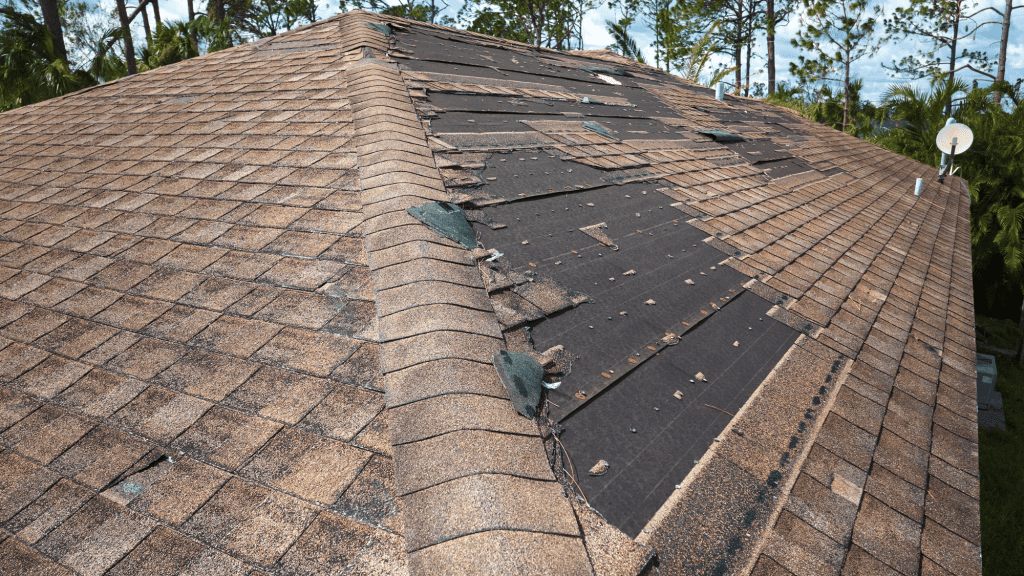
Securing your financial well-being in the face of unexpected roof damage in Sugar Bush Knolls, OH, hinges on the pivotal role played by the insurance company. Yet, navigating the intricate landscape of insurance coverage can be a daunting task. A thorough understanding of policy distinctions, like Actual Cash Value (ACV) and Replacement Cost Value (RCV), and a keen awareness of prevalent exclusions can exert a substantial influence on the handling and eventual resolution of your claim.
Policy Types: ACV vs RCV
For roof replacement coverage, an Actual Cash Value (ACV) policy is structured to reimburse you for the depreciated value of your roof, deducting the applicable deductible. In simpler terms, this means you’ll receive compensation based on the current value of your roof at the time of the damage. However, it’s important to understand that this amount may not cover the full expense of repairs or replacement.
On the other hand, a Replacement Cost Value (RCV) policy offers a more comprehensive solution. It covers the complete cost of roof replacement, providing funds for a new roof based on current market prices and materials. With an RCV policy, you’ll initially receive a check for the actual cost value of your roof. After the roof replacement is finished, a second check for the remaining amount will be issued, provided all requirements are met.
The choice of a suitable policy for your needs can greatly impact the payout you receive in the event of a roof damage claim, making it an important decision. It is essential to:
- Review your insurance policy
- Understand the differences between ACV and RCV
- Consult with your home insurance company to ensure you have the appropriate coverage for your specific situation.
Common Exclusions
Safeguarding your home from weather-related roof damage in Sugar Bush Knolls, Ohio, with homeowners insurance is a wise decision, but it’s equally important to be aware of common exclusions that might impact your claim, like:
- improper installation, which refers to deviating from the manufacturer’s instructions or local building codes during roof installation. Such deviations can lead to accelerated wear and tear and potentially invalidate your roof’s warranty.
- Neglecting routine maintenance is another exclusion, involving tasks like cleaning gutters and removing debris. Damages resulting from insufficient maintenance may not be covered by your insurance policy.
- Additionally, some policies may exclude coverage for specific weather events, such as hurricanes or earthquakes.
A thorough review of your insurance policy is essential to understand these exclusions and ensure you have the appropriate coverage for your roof. Inadequate maintenance occurs when a roof is not regularly inspected and maintained according to the manufacturer’s instructions or local building codes, possibly resulting in premature deterioration and warranty invalidation.
Understanding these exclusions and taking steps to ensure proper roof installation, regular maintenance, and protection from excluded weather events can help you avoid potential claim denials and ensure you receive the coverage you deserve.
Sugar Bush Knolls Roof Damage - Filing an Insurance Claim
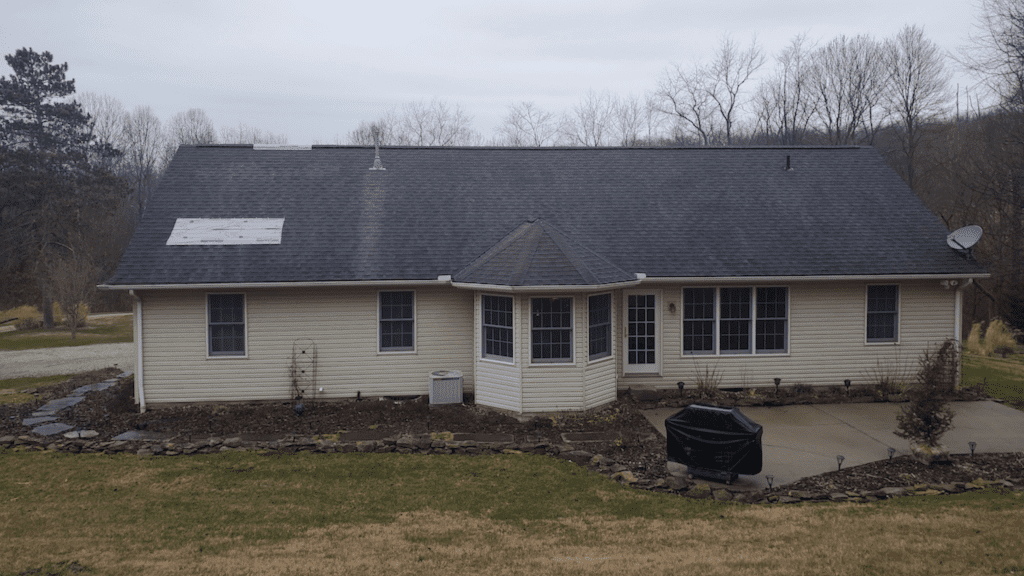
Grappling with roof damage in Sugar Bush Knolls, OH, and filing an insurance claim demands a careful and thorough strategy. Successfully navigating this process involves adeptly documenting the damage, establishing effective communication with insurance adjusters, and making informed choices when selecting a roofing contractor.
This guide is your roadmap, offering detailed steps and insightful tips to ensure a hassle-free and successful insurance claims experience for roof damage.
Documenting the Damage
A systematic documentation approach is essential when filing an insurance claim for roofing damage. Follow these steps:
- Capture comprehensive photos of the damaged areas, highlighting any missing shingles, raised flashing, or damaged tiles.
- Create a detailed list of the damage, accompanied by thorough notes, including dates, times, and any pertinent weather events contributing to the damage.
- If preventive measures have been taken, such as securing tarps to the roofing, document these measures through photographs.
After documenting the damage, obtain an estimate from a qualified roofing contractor to assess the repair or replacement costs. This estimate not only provides clarity on the extent of the damage but also serves as crucial documentation when filing your claim with the insurance company. A comprehensive and accurate record of the roofing damage significantly enhances the chances of a successful claim.
Working with Adjusters
In Sugar Bush Knolls, roof damage insurance adjusters are integral to the claims process as they evaluate the damage to your roof and calculate the value of your claim payout. Working effectively with adjusters can be the key to getting the best possible outcome for your claim. It is essential to provide accurate information, maintain records of all interactions and documents related to the claim, and remain truthful throughout the process.
If your claim is denied, you have options to pursue a resolution. You can:
- Ask your insurance company for a different adjuster to get a second opinion
- Consult a structural engineer for an inspection and proof of the damage
- Pursue legal avenues as a last resort
By understanding the role of adjusters and being prepared to work with them, you can increase the likelihood of a successful claim and receive the coverage you need to repair or replace your damaged roof.
Choosing a Reputable Roofing Contractor
The choice of a reputable roofing contractor plays a vital role in ensuring both quality work and a smooth insurance claims process. When investigating roofing contractors for insurance claims, it’s essential to consider factors such as their experience with claims, turnaround times, and their ability to collaborate with adjusters. A qualified roofing contractor excels in accurately documenting damage according to insurance companies specifications and providing expert assessments.
Opting for a local and reliable roofing contractor, such as Pine Ridge Roofing, provides peace of mind regarding the handling of your roof repair or replacement. Their team of certified roofers and insurance specialists is committed to assisting with storm repair, restoration, and insurance claims in Sugar Bush Knolls, OH, and the neighboring areas. Choosing an experienced roofing contractor is a surefire way to guarantee the safety and integrity of your home.
Sugar Bush Knolls Roof Damage - Preventative Measures and Maintenance

While insurance can provide financial protection for weather-related roof damage, taking preventative measures and maintaining your roof can help you avoid costly repairs or replacements in the first place. This section highlights the importance of routine inspections, appropriate ventilation, and waterproofing for maintaining your roof in prime condition and minimizing the risk of weather-related damage.
Routine Inspections
Regular roof inspections serve as an effective method to spot and tackle potential issues before they escalate into significant problems. Inspections should evaluate the roof for signs of:
- Deterioration
- Missing or damaged shingles
- Debris in the gutters
- Roof ponding
It is recommended that routine roof inspections be conducted at least 2 times a year or more frequently if the roof is exposed to extreme weather conditions.
By staying proactive with routine inspections, you can address minor issues before they escalate, ultimately saving money by avoiding expensive repairs or replacements. Hiring a reputable roofing contractor to perform these inspections can provide an expert assessment of your roof’s condition and help you maintain its integrity for years to come.
Call us now and schedule your free roof inspection with Pine Ridge Roofing.
Proper Ventilation and Waterproofing
To prevent the damaging effects of moisture buildup, ice dams, and other weather-related concerns on your roof, it is crucial to prioritize proper ventilation and waterproofing. Key practices include:
- Maintaining good indoor air quality
- Implementing effective home ventilation
- Utilizing exhaust fans and air purifiers
- Installing a reliable ventilation system
- Ensuring the proper attachment of roof ventilation products.
Neglecting these aspects may lead to issues like moisture accumulation and ice dams, potentially resulting in costly repairs and replacements. By prioritizing adequate roof ventilation and waterproofing, you can significantly reduce the risk of damage and extend the performance and lifespan of your roofing materials.
Pine Ridge Roofing: Your Partner in Roof Repair and Insurance Claims
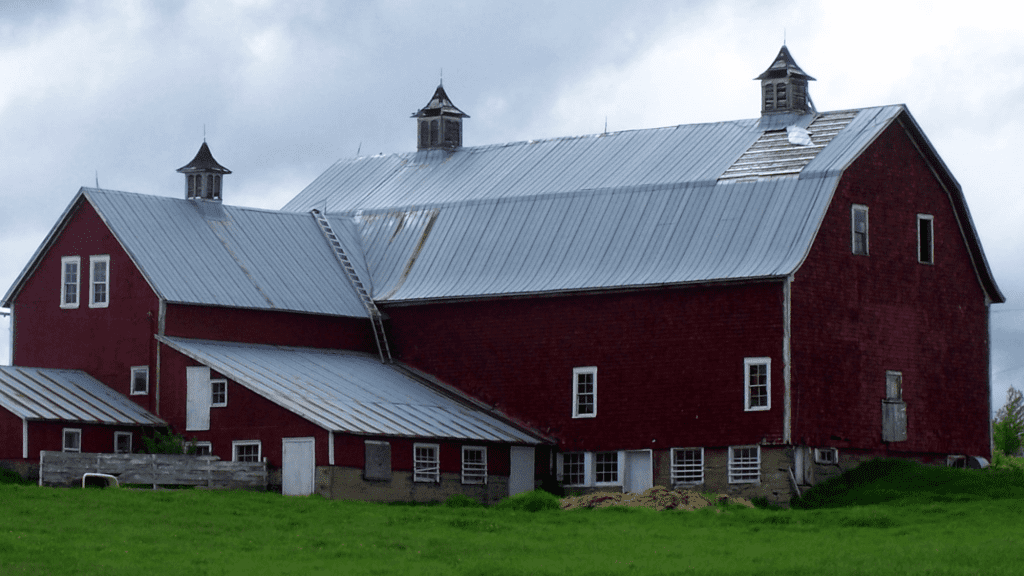
Pine Ridge Roofing, serving Sugar Bush Knolls, Ohio, and surrounding areas, specializes in:
- Storm damage repairs
- Insurance claims
- Emergency inspection
- Tarping services
- Assistance with insurance claims for weather-related roof damage
- Roof replacements
- Siding repair and replacement
- Gutter repair and replacement
- Leaf Guard Installation
- Deck building
With a combined experience exceeding 25 years, our team of certified roofers and insurance specialists is unwavering in its commitment to providing excellent roof repairs. We are dedicated to safeguarding and restoring your home following any weather-related damage event.
Emergency Inspection and Tarping Services
Suspecting roof damage? Schedule a free emergency inspection with Pine Ridge Roofing to evaluate the extent of the damage and determine the best course of action for repairs or replacement. Our team of experts performs a thorough assessment of your roof, identifying any missing shingles, lifted flashing, or cracked tiles that may need immediate attention.
In addition to emergency inspections, Pine Ridge Roofing offers the following services:
- Tarping services provide temporary protection and prevent any further damage to your roof.
- Act quickly by securing your roof with tarps to minimize the risk of additional damage.
- We ensure your home stays safe and secure throughout the insurance claim process.
Insurance Claim Assistance
Navigating the insurance claim process can be overwhelming, but Pine Ridge Roofing is here to help. They offer the following services:
- Assisting with insurance claims
- Representing homeowners
- Negotiating with insurance companies
- Providing quality roof replacement services
When it comes to insurance claims, Pine Ridge Roofing’s expertise guarantees the best possible outcome, allowing you to prioritize your family’s safety and well-being. Their insurance claim assistance includes:
- emergency inspections
- tarping damaged areas
- representing homeowners during insurance adjuster meetings
- negotiating with insurance companies
- utilizing top-notch products such as Owens Corning shingles and synthetic felt for roof replacements.
With Pine Ridge Roofing, you can trust that your roof repair or replacement will be handled professionally and efficiently, ensuring the protection of your home.
Summary
Tackling roof damage in Sugar Bush Knolls, Ohio caused by weather demands careful consideration from homeowners. It’s essential to discern the types of damage, skillfully navigate insurance claims, and proactively care for your roof. This extensive guide provides invaluable information. Teaming up with Pine Ridge Roofing, a reliable contractor, ensures you’re well-prepared to handle any weather-related roof damage, securing the well-being of your home and family.
Frequently Asked Questions
Does Home Insurance Cover Roof Storm Damage?
The extent of coverage for roof storm damage under your home insurance policy is determined by the details specified in the plan. Generally, insurance plans encompass protection against damage caused by hail, wind, destruction from falling objects, and internal damage due to roof storm damage. For instance, if a storm leads to the destruction of your roof and subsequent rainwater damage to the ceiling, your insurance policy is designed to cover the repairs for both the roof and ceiling.
Are blown-off shingles covered by insurance?
Understanding the essential nature of roofs, insurance firms typically account for potential damage and cover the costs associated with replacing a roof when unforeseeable events lead to the loss of shingles.
What is considered wind damage to shingles?
Shingles, when subjected to strong winds, can exhibit telltale signs of damage such as tearing, creasing, or detachment from the roof structure. This vulnerability is more pronounced in three-tab shingles, attributed to the repetitive lifting or flapping they undergo. It’s important to note that unsealed shingles are generally immune to these issues unless accompanied by visible physical mat damage.
My roof doesn’t leak. Does this mean my roof is okay?
The absence of visible leaks doesn’t guarantee your roof’s overall health. Roof damage may exist undetected, with leaks only surfacing later on. Pine Ridge Roofing employs skilled experts equipped with tools and techniques to uncover hidden moisture and identify potential damage. Our thorough inspections go beyond what meets the eye, ensuring a comprehensive understanding of your roof’s condition. Take proactive steps by scheduling a free inspection now!
What is the most common roof damage?
Roof damage in Sugar Bush Knolls, OH, particularly leaking roofs, is a prevalent issue. This is commonly a result of broken shingles, inadequate flashing around chimneys or gutters, and near vents or pipes.
